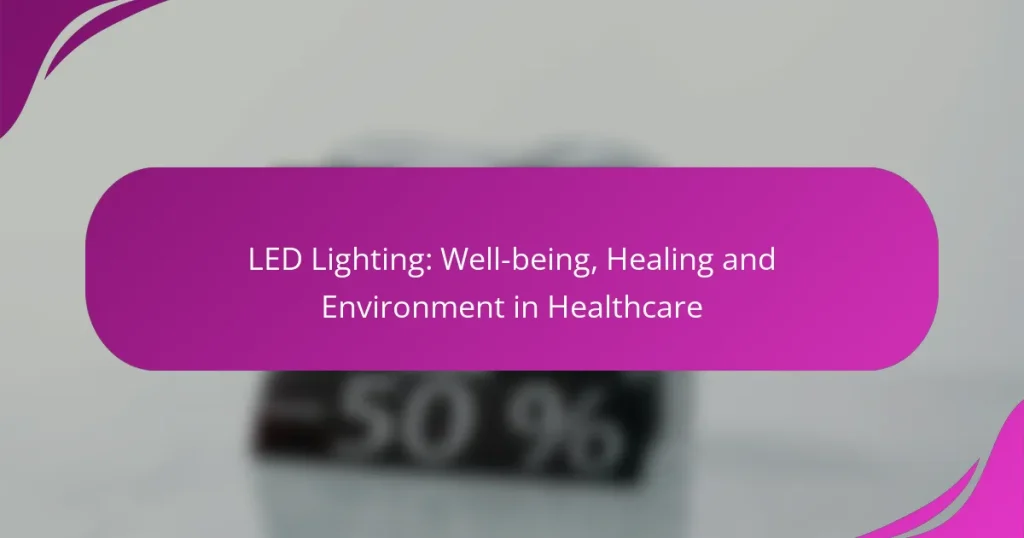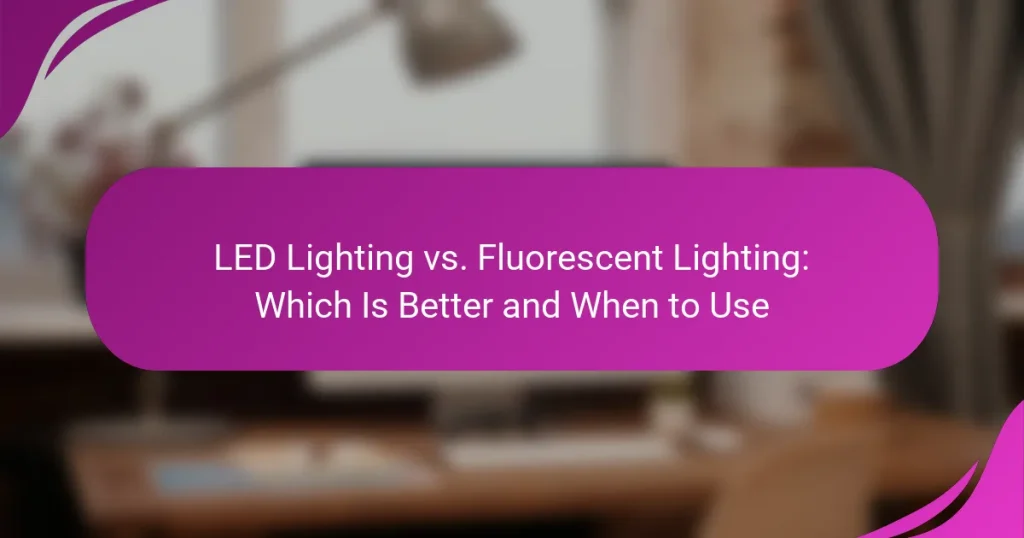LED lighting provides numerous health and safety benefits, making it an ideal choice for both homes and workplaces. Its superior light quality can reduce eye strain, enhance mood, and improve productivity, while also minimizing the risk of headaches. Additionally, LED lights contribute to a safer environment by lowering heat emissions and improving visibility, thereby reducing potential hazards associated with traditional lighting methods.
LED Lighting vs. Fluorescent Lighting: Which Is Better and When to Use
LED Lighting: Safety, Visibility and Security
LED Lighting: Eye Health, Comfort and Productivity
What are the health benefits of LED lighting in the UK?
LED lighting offers several health benefits in the UK, including reduced eye strain, improved mood and productivity, and a lower risk of headaches. These advantages stem from the quality of light emitted by LEDs, which can enhance visual comfort and overall well-being.
Reduced eye strain
LED lighting can significantly reduce eye strain, especially in environments where people spend long hours working, such as offices and homes. The flicker-free technology and adjustable brightness levels help create a more comfortable viewing experience.
To minimize eye strain, consider using LED lights with a color temperature around 4000K to 5000K, which closely resembles natural daylight. This can help maintain alertness and reduce fatigue during extended periods of reading or screen time.
Improved mood and productivity
Exposure to LED lighting can positively influence mood and productivity levels. Bright, cool white light can enhance alertness and concentration, making it easier to focus on tasks. Studies suggest that environments with appropriate lighting can lead to increased job satisfaction and efficiency.
For optimal results, use LED lights that mimic natural daylight, especially in workspaces. Incorporating adjustable lighting options can allow individuals to tailor their environment to their specific needs throughout the day.
Lower risk of headaches
LED lighting can help lower the risk of headaches, particularly those triggered by harsh or flickering light sources. The stable light output of LEDs reduces glare and minimizes the likelihood of discomfort that can lead to migraines or tension headaches.
To further reduce headache risks, ensure that LED fixtures are properly installed and positioned to avoid direct glare. Utilizing dimmable LED options can also help individuals adjust the lighting to their comfort level, further decreasing the chances of headache occurrences.
How does LED lighting enhance safety?
LED lighting enhances safety by reducing hazards associated with traditional lighting methods. Its lower heat emission, improved visibility, and decreased fire risk contribute to a safer environment in both residential and commercial settings.
Lower heat emission
LED lights produce significantly less heat compared to incandescent or halogen bulbs. This lower heat emission minimizes the risk of burns and heat-related accidents, making them safer for use in homes and workplaces.
When installed in enclosed fixtures or near flammable materials, the reduced heat output of LEDs can prevent potential fire hazards. This is particularly important in settings like kitchens or storage areas where heat accumulation can be dangerous.
Improved visibility
LED lighting provides brighter and more focused illumination, which enhances visibility in various environments. This improved visibility is crucial for safety in areas such as stairways, parking lots, and outdoor pathways.
With options for adjustable brightness and color temperature, LED lights can be tailored to specific needs, ensuring that spaces are well-lit and reducing the likelihood of accidents caused by poor visibility.
Reduced risk of fire hazards
The use of LED lighting significantly lowers the risk of fire hazards due to their efficient energy use and low heat generation. Unlike traditional bulbs that can overheat, LEDs remain cool to the touch, making them safer for prolonged use.
In addition, LEDs have a longer lifespan, which means less frequent replacements and reduced waste. This longevity contributes to a safer environment by minimizing the chances of malfunction or failure that could lead to fire risks.
What are the energy efficiency advantages of LED lighting?
LED lighting offers significant energy efficiency advantages over traditional lighting options, primarily through lower energy consumption and longer operational lifespans. These benefits not only reduce electricity usage but also contribute to lower overall costs for consumers and businesses.
Lower energy consumption
LED lights consume considerably less energy compared to incandescent and fluorescent bulbs. While traditional bulbs may use around 60-100 watts, LED bulbs typically operate on just 8-15 watts for similar brightness levels. This reduction in energy usage directly translates to lower electricity bills.
Additionally, LEDs convert a higher percentage of energy into light rather than heat, making them more efficient. For example, an LED bulb can produce the same amount of light as a 60-watt incandescent bulb while using only about 10 watts.
Longer lifespan compared to traditional bulbs
LED lighting boasts a lifespan that can exceed 25,000 hours, significantly outlasting traditional incandescent bulbs, which last about 1,000 hours. This longevity means fewer replacements and less waste, making LEDs a more sustainable choice.
The extended lifespan of LEDs is due to their solid-state technology, which is less prone to failure than the fragile filaments in incandescent bulbs. This durability is particularly beneficial in hard-to-reach areas where changing bulbs can be inconvenient and costly.
Cost savings on electricity bills
The energy efficiency of LED lighting leads to substantial cost savings on electricity bills. Households and businesses can save up to 80% on lighting costs by switching to LEDs. This reduction can lead to hundreds of dollars in savings annually, depending on usage and local electricity rates.
Moreover, many regions offer incentives or rebates for switching to energy-efficient lighting, further enhancing the financial benefits. By investing in LED technology, consumers not only save money but also contribute to energy conservation efforts.
What regulations govern LED lighting safety in the UK?
In the UK, LED lighting safety is primarily governed by the Electrical Equipment (Safety) Regulations and the UKCA marking requirements. These regulations ensure that LED products meet essential safety standards to protect users from electrical hazards and ensure environmental safety.
Compliance with UK lighting standards
LED lighting must comply with various UK lighting standards, including the British Standard BS 60598 for luminaires. These standards dictate performance criteria, ensuring that products are safe, reliable, and suitable for their intended use. Regular testing and certification by recognized bodies are essential to confirm compliance.
Manufacturers should ensure their LED products are marked with the appropriate certification symbols, indicating adherence to these standards. This not only guarantees safety but also enhances consumer trust in the product.
RoHS compliance for hazardous substances
The Restriction of Hazardous Substances (RoHS) Directive is crucial for LED lighting products in the UK, limiting the use of specific hazardous materials. Compliance with RoHS ensures that LED lights do not contain harmful substances like lead, mercury, or cadmium, which can pose health and environmental risks.
Manufacturers must conduct thorough testing and maintain documentation to demonstrate RoHS compliance. This includes sourcing materials from suppliers who also adhere to these regulations, ensuring the entire supply chain meets safety standards.
How to choose safe LED lighting products?
To choose safe LED lighting products, prioritize reputable brands, verify safety certifications, and consider warranty options. These factors ensure that the products meet safety standards and provide reliable performance.
Look for reputable brands like Philips or Osram
Choosing LED lighting from established brands such as Philips or Osram is crucial for safety and quality. These companies have a long history of producing reliable lighting solutions that comply with safety regulations.
Reputable brands often invest in research and development, leading to better energy efficiency and longer lifespans. Look for products that come with positive customer reviews and industry recognition.
Check for safety certifications
Safety certifications indicate that LED lighting products have been tested for compliance with safety standards. Look for labels such as UL, CE, or RoHS, which signify adherence to specific safety and environmental regulations.
These certifications help ensure that the products are free from hazardous materials and operate safely under normal conditions. Always check the packaging or product details for these certifications before making a purchase.
Consider warranty and customer support
A good warranty reflects the manufacturer’s confidence in their product’s quality. Look for LED lighting products that offer warranties ranging from two to five years, as this can protect your investment against defects and failures.
Additionally, consider the availability of customer support. Brands that provide accessible support can assist with installation issues or product inquiries, enhancing your overall experience with the product.
What are the potential risks associated with LED lighting?
LED lighting can pose several risks, particularly related to blue light exposure and quality inconsistencies among manufacturers. Understanding these risks is essential for making informed choices about LED products.
Blue light exposure concerns
Blue light emitted by LED lights can disrupt sleep patterns and contribute to eye strain. Prolonged exposure, especially during evening hours, may interfere with melatonin production, making it harder to fall asleep.
To mitigate these effects, consider using LED lights with a warmer color temperature in the evening. Look for bulbs labeled as “warm white” or those that emit less blue light, typically around 2700K to 3000K.
Quality variations among manufacturers
The quality of LED lighting can vary significantly between manufacturers, affecting brightness, color accuracy, and longevity. Cheaper options may not meet safety standards, leading to potential hazards like overheating or flickering.
When selecting LED products, prioritize reputable brands that comply with recognized standards such as the Energy Star certification. Checking reviews and warranty offerings can also help ensure you choose reliable lighting solutions.
How can LED lighting improve workplace safety?
LED lighting enhances workplace safety by providing better visibility and reducing hazards associated with poor lighting conditions. It minimizes glare and shadows, which can lead to accidents and injuries.
Enhanced task lighting
Enhanced task lighting is crucial for activities that require precision and focus. LED lights can be directed to specific areas, ensuring that workspaces are well-lit without creating excessive brightness that can cause discomfort.
For example, in assembly lines or detailed inspection areas, using LED task lights can increase productivity and reduce errors. Consider installing adjustable LED fixtures that allow workers to customize lighting levels based on their tasks.
When selecting LED task lighting, look for options with a color temperature around 4000K to 5000K, which closely mimics natural daylight and helps maintain alertness. Avoid overly bright lights that can lead to eye strain and fatigue.



